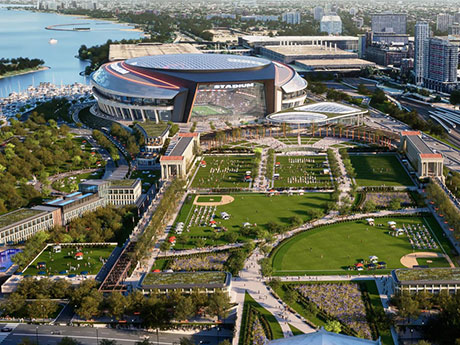CHICAGO — The NFL’s Chicago Bears have released their plans for the development of a new fixed-roof stadium along Chicago’s lakefront. Local media reports state that the project cost is $3.2 billion. Plans call for a publicly owned multipurpose stadium located just south of the organization’s current Soldier Field.
The proposal boasts year-round use for recreational and community events and an increase in open and green space, including 14 acres of athletic fields and park space for use by public and youth sports programs. The plan features a three-acre promenade and plaza area, which could include year-round food-and-beverage outlets, retail shops, and a cultural attraction focused on sports and Soldier Field history. A publicly owned hotel could also be included in this portion.
The stadium would be capable of hosting large-scale sporting events year-round, including Super Bowls and NCAA Final Fours, as well as entertainment acts.
Additional project features include a pedestrian mall and pavilion, a wider variety of food-and-beverage options, more public restrooms, and the preservation of Soldier Field’s historic colonnades, which will remain accessible to fans and continue to honor military personnel.
The Bears have pledged to contribute more than $2 billion to the project, representing over 70 percent of the total stadium cost. The remaining stadium funds are proposed to come from the Illinois Sports Facilities Authority (ISFA), a government entity that was created by the Illinois General Assembly in 1987 for the purpose of constructing and renovating sports stadiums for professional teams. According to the Bears, the project can be accomplished with the existing 2 percent hotel tax used to back ISFA bonds.
The construction of the stadium and associated improvements would be one of the largest building projects in the region’s history, representing $4.2 billion of direct capital investment, according to the Bears. The project would boast over $8 billion in regional construction economic impact, a $456 million annual economic impact post construction, the creation of 43,000 regional construction jobs and 4,200 permanent jobs post construction.
Annual tax revenue from ongoing operations is projected to be 58 percent higher for the City of Chicago and 41 percent higher for the State of Illinois with the replacement stadium over the current operation of Soldier Field.
The proposal also includes easing traffic circulation via a three-phase infrastructure improvement plan. Phase I consists of requirements to open the stadium, including transportation, roadways and utilities, and would cost an estimated $325 million.
The Bears aim to break ground in summer 2025, with a planned grand opening in summer 2028.
“The Bears have been proud to call Chicago home for more than 100 years,” says George McCaskey, Bears chairman. “Our founder, George Halas, emphasized the importance of being a champion for Chicago.”
Previously, a venture controlled by the team paid $197 million for the shuttered Arlington International Racecourse property in the suburb of Arlington Heights and subsequently unveiled plans for a $5 billion stadium and entertainment district. Crain’s Chicago Business reports that the Bears said they would only move ahead with that redevelopment if they could secure taxpayer help to finance the mixed-use portion of the proposed campus.


